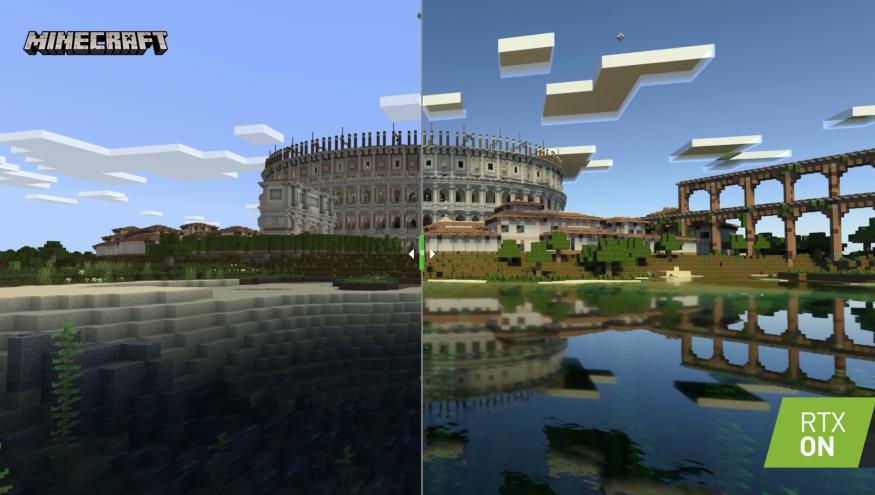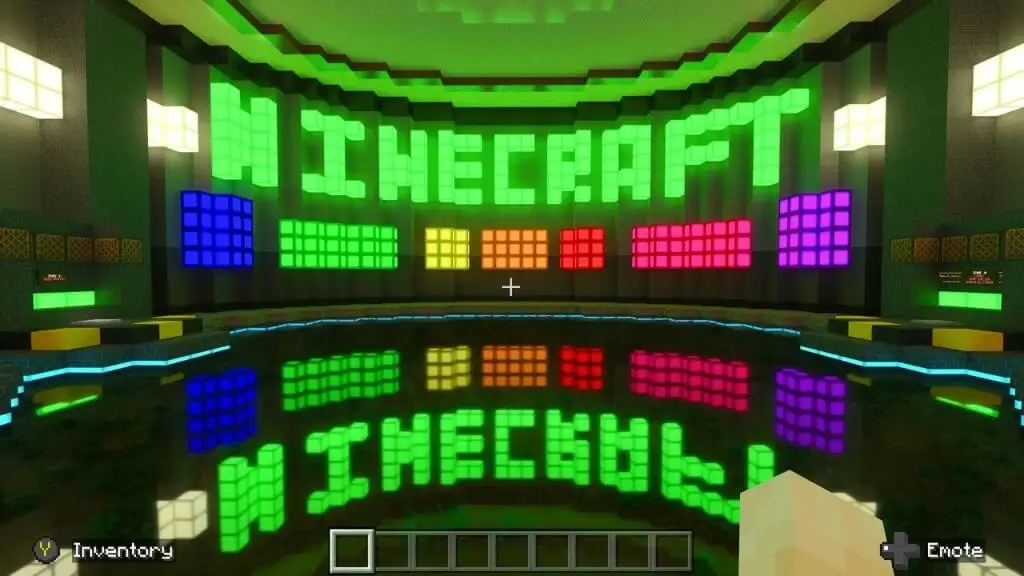In the realm of digital landscapes and pixelated adventures, Minecraft stands as an iconic testament to boundless creativity and exploration. However, in recent times, a groundbreaking technology has breathed new life into the game’s familiar blocks and textures, ushering in a visual revolution that blurs the lines between virtual and reality. This transformation is none other than ray tracing, a sophisticated rendering technique that catapults Minecraft into the realm of unparalleled visual fidelity.
Imagine stepping into a world where sunlight dances off reflective waters, casting dynamic shadows that shift with the passing clouds. Envision exploring dense forests where each leaf resonates with lifelike vibrancy, and entering dimly lit caves that come alive with ambient occlusion and natural lighting. All this and more becomes possible through ray tracing, an innovation that harnesses the power of light itself to recreate an astonishingly authentic virtual environment.
However, this immersive leap into realism isn’t as simple as flipping a switch. Integrating ray tracing into your Minecraft experience requires a fusion of cutting-edge hardware and software configuration. The journey to unlock this visual spectacle involves understanding the technology behind ray tracing, ensuring compatibility with your gaming setup, and navigating the intricate settings within the game itself.
In this comprehensive guide, we will take you through the steps to activate ray tracing in Minecraft, unveiling the intricate process that transforms blocks into veritable architectural marvels. From deciphering the hardware prerequisites that lay the foundation for this graphical marvel, to delving into the in-game menus that allow you to fine-tune ray tracing settings, we leave no stone unturned. Whether you are a seasoned Minecraft veteran or a newcomer eager to witness the game’s evolution, this guide is tailored to assist you in embarking on your ray-traced journey.
Prepare to witness the dawn of a new era in gaming aesthetics as we embark on this visual voyage. The world of Minecraft has never been so enchanting, so captivating, and so unbelievably real – all thanks to the magic of ray tracing.
What is Ray Tracing in Minecraft?

Ray tracing in Minecraft is a cutting-edge rendering technique that simulates the behavior of light in a remarkably realistic manner. It aims to recreate the way light interacts with various surfaces and materials, resulting in a level of visual fidelity previously unseen in the game. By tracing the path of individual rays of light as they bounce, refract, and reflect off objects, ray tracing can produce stunningly lifelike effects such as dynamic shadows, accurate reflections, and ambient occlusion.
In traditional rendering methods, such as rasterization, lighting and shadows are often approximated to achieve real-time performance. While these techniques have served the gaming industry well, they often fall short in delivering true-to-life visuals. Ray tracing, on the other hand, computes lighting effects in a much more physically accurate manner, resulting in scenes that closely resemble the behavior of light in the real world.
In the context of Minecraft, ray tracing takes the iconic blocky world and transforms it into a realm of astonishing realism. Water surfaces now exhibit realistic reflections, with light bouncing off waves and creating ripples. Shadows cast by objects are dynamic and change in real time as the light source moves. Ambient occlusion enhances the sense of depth and realism by simulating how light is blocked in crevices and corners. Even transparent materials like glass refract light accurately, creating dazzling visual effects.
Implementing ray tracing in Minecraft is not merely a graphical upgrade; it’s a technological leap that allows players to experience the game in a way that’s closer to the visual quality of high-end CGI in movies. However, due to the computational demands of ray tracing, it requires substantial hardware power to run smoothly, and not all gaming systems are capable of supporting it.
Nonetheless, the introduction of ray tracing in Minecraft showcases the industry’s dedication to pushing the boundaries of visual fidelity in gaming. It transforms the familiar blocky landscapes into breathtaking vistas, offering players a chance to immerse themselves in a world that captures the beauty and complexity of natural lighting phenomena.
Where to find Ray Tracing in Minecraft?

To find and experience ray tracing in Minecraft, You would need to follow these general steps:
- Choose a Compatible Version: Ensure you have a version of Minecraft that supports mods or specialized versions with ray tracing capabilities. Mods are typically developed for specific Minecraft versions, so make sure you’re using the correct version for the mod you want to use.
- Install a Ray Tracing Mod: Look for mods that introduce ray tracing technology to Minecraft. Popular mods like “SEUS (Sonic Ether’s Unbelievable Shaders)” and “Continuum Shader” have been known for adding ray tracing effects to the game. These mods can enhance lighting, shadows, reflections, and other visual aspects using ray tracing techniques. Remember that modding might involve downloading files from sources outside the official game, so exercise caution and ensure you’re getting them from reputable sources.
- Install Optifine: Optifine is a popular optimization mod for Minecraft that can improve performance and add various graphical enhancements, including support for shaders and ray tracing. Installing Optifine can be a prerequisite for running some ray tracing mods smoothly.
- Adjust Settings: Once you have the ray tracing mod installed and configured, you’ll likely have access to a variety of settings and options to fine-tune the ray tracing effects. These settings can have a significant impact on both visuals and performance, so experimentation might be necessary to find the balance that suits your hardware.
-
Enjoy the Experience: Launch the modified version of Minecraft, and you should be able to witness the enhanced graphics and ray tracing effects in action. Explore your world to see how lighting, shadows, reflections, and other visual aspects have been transformed.
What Does Ray Tracing Do in Minecraft?
Ray tracing in Minecraft brings a new level of realism and visual sophistication to the game by simulating the behavior of light in a highly accurate manner. It enhances various visual aspects of the game world, creating a more immersive and lifelike experience for players. Here’s what ray tracing does in Minecraft:
- Realistic Lighting and Shadows: Ray tracing accurately simulates how light interacts with different surfaces and materials. This results in dynamic and lifelike lighting effects, such as soft shadows that change based on the position and intensity of light sources. Shadows cast by objects and structures appear realistic and respond dynamically to changes in lighting conditions.
- Reflections and Refractions: Ray tracing enables accurate reflections on surfaces like water, glass, and metal. When you’re near a body of water, you’ll see the surrounding environment accurately reflected on its surface. Transparent materials like glass will refract light, creating realistic distortion effects.
- Ambient Occlusion: Ambient occlusion is a shading technique that enhances the perception of depth and realism by simulating how light is blocked or occluded in areas where objects come into close contact. This adds subtle shadows to corners, crevices, and intersections, making the world feel more three-dimensional.
- Global Illumination: Ray tracing introduces global illumination, which means that light bounces and affects the entire scene. This leads to more natural and realistic lighting interactions, with light from one object affecting the colors and illumination of nearby surfaces.
- Materials and Textures: Ray tracing enhances the appearance of various materials and textures in the game. Surfaces can appear more tactile and lifelike, with details and imperfections becoming more pronounced due to the way light interacts with them.
- Atmospheric Effects: Ray tracing can also be used to simulate atmospheric effects, such as volumetric lighting and scattering. This creates more realistic sunsets, sunrises, and other atmospheric phenomena.
- Aesthetic Enhancement: Overall, ray tracing gives Minecraft a visual makeover that brings the game’s environments to life with stunning realism. The game’s blocky structures and landscapes benefit from the technology, offering players a fresh perspective on a familiar world.
It’s important to note that ray tracing is computationally intensive and requires powerful hardware to run smoothly, as it involves tracing the paths of individual rays of light in real time. The introduction of ray tracing to Minecraft showcases the game’s potential for visual evolution and highlights how technology can transform even the most iconic and well-known virtual worlds.
Minecraft Ray Tracing Requirements
Here are some general guidelines for the hardware you might need:
Graphics Card: A modern and high-end graphics card is essential for ray tracing in Minecraft. Look for GPUs from Nvidia’s RTX series (such as RTX 20XX and 30XX) or AMD’s RDNA2-based GPUs (such as the RX 6000 series). These graphics cards are designed to accelerate ray tracing and deliver the necessary performance for smooth gameplay.
CPU: A capable processor is also important to ensure that your system can handle both the ray tracing calculations and the overall gameplay. A recent and powerful CPU from Intel (e.g., Core i7 or higher) or AMD (e.g., Ryzen 7 or higher) should suffice.
Memory (RAM): Aim for at least 16 GB of RAM or more. This will provide ample memory for the game, the operating system, and any other background processes.
Storage: A solid-state drive (SSD) is recommended to ensure quick loading times and smooth asset streaming, which can contribute to a better gaming experience.
Display: A high-resolution monitor (e.g., 1440p or 4K) will allow you to fully appreciate the enhanced visuals brought by ray tracing. Make sure your monitor supports the resolution and refresh rate you desire.
Power Supply: With high-performance components, you’ll need a power supply unit (PSU) that can provide enough wattage to support your hardware.
Operating System: Ensure you’re using a compatible and up-to-date operating system. Most ray tracing technologies are optimized for Windows.
Modding: If you’re using ray tracing mods, make sure they are compatible with the version of Minecraft you’re playing. Also, double-check the mod’s specific system requirements, as they might vary.
Software: You’ll need to use a version of Minecraft that supports ray tracing mods, as well as the appropriate mods and shaders themselves.
Keep in mind that ray tracing can significantly impact performance, especially when using higher-quality settings. You might need to adjust in-game settings to find the right balance between visuals and performance, and not all hardware configurations will be able to achieve consistently high frame rates with ray tracing enabled.
Conclusion!
In conclusion, unlocking the stunning potential of ray tracing in Minecraft is a journey that brings a new level of visual immersion to this iconic game. By harnessing advanced lighting and rendering techniques, ray tracing elevates the virtual world of Minecraft to unprecedented levels of realism. However, the process isn’t as simple as flicking a switch within the game. Ray tracing is a revolutionary technology that simulates the behavior of light in a lifelike manner, transforming the visual experience of Minecraft into one that closely mirrors the complexities of the real world. Unlike standard game features, ray tracing in Minecraft is achieved through third-party modifications or mods. These mods introduce the intricate calculations necessary for ray tracing effects.










